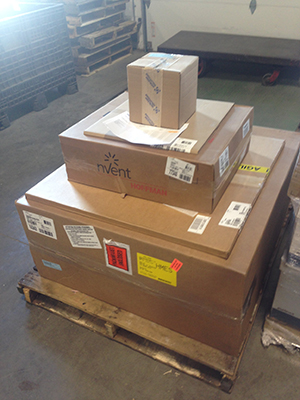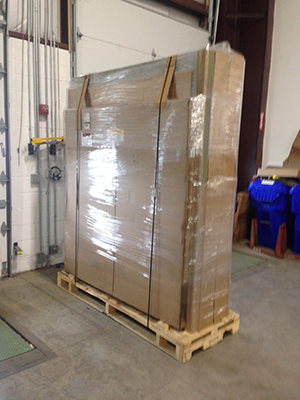
Blog > Automation > Best Practices for Large Enclosures
Best Practices for Large Enclosures
12/3/19 | Will Cole, Rexel Technical Consultant
If you work with electrical and automation control devices, then you work with enclosures. They’re those big gray boxes that protect your critical mechanisms. This blog post will help you get a better understanding, specifically of large enclosures. We’ll cover these five topics:

- Dimensions
- Sizing
- Weight
- Logistics
- Safety
In this post, we won’t get into all the technical ins and outs of making a selection. We don’t have space to talk about NEMA1 versus 12 versus 4 versus 4X. Those topics are covered elsewhere (Good Panel Design, 5 Best Practices for Drive Enclosures). Rather, today we’ll help you better understand an enclosure that has already been specified and chosen for a project.
Dimensional Guidelines
Most enclosures are cube shaped, with three dimensions, namely: height (H, A), width (W, B), and depth (D, C). The A, B, C styled dimensional naming is common to Hoffman enclosures. In common talk, both verbal and email, folks tend to use a convention of HH(A)xWW(B)xDD(C). A very common dimension would be a 24” x 24” x 8”, or 24248. Same thing.
One tiny twist is how to stylize a dimension like a depth of eight inches. Some folks call it out as 24” x 24” x 8”, and others use a part number like 242408, with the extra zero character. Both are accepted conventions.
Sizing Guidelines

I classify enclosures into three broad categories: small, medium, and large. Here’s what I use as rules of thumb:
- Small enclosures run from 8”, 10”, and 12” dimensions up to the 24-30” range.
- Medium classification covers 24-30” on one end up to 48”-ish on the bigger end.
- Large enclosures cover anything 60” and up, with the 72” dimension being quite common in industrial control panels.
Important Note: Classify based on the largest dimension. Meaning, a 72” H x 24” W x 24” is still a large enclosure. Why does this small, medium, and large classification matter? One of the best uses cases is to provide a guideline as to what to expect for shipping logistics.
- Small are typically able to be shipped via UPS, FedEx, and other parcel carriers.
- Medium can ship via multiple methods, they’re often an “in-betweener” and logistics depend on if you have 1 or 4 or 10.
- Large enclosures will almost always need to go on their own dedicated skid or pallet, and the larger you go, the more possible “gotcha” moments there are.
This blog post focuses on the large enclosures, giving you good tools to avoid those “gotcha” moments. For example, we can take a quick look at the 72” x 24” x 24” enclosure mentioned above: A722424SSFSDAN4. This is indeed large—and heavy. It weighs in at roughly 350 lbs. and comes standard with x2 heavy-duty lifting eyes, as pictured.
Weight Guidelines
To help you move from “rough guess” guidelines to actual business transactions, one very helpful piece of data is weight. Remember how I said a very common enclosure would be a 24” x 24” x 8”? The actual part number I am thinking of is CSD24248. This enclosure weighs in at 40 lbs. empty. If we have cut some HMI and pushbutton holes, it might weigh 38.2 lbs since there is now less metal. Or, if we took a base CSD24248 and added a backplate, DIN rail, panel duct, wire, and devices, it might weigh 75 lbs., 100 lbs., or more. It all depends on what type of devices you have mounted. For very quick and rough calculations, you can take the weight of the empty enclosure and double it for an estimate of what it might weigh fully populated.
I mentioned that small enclosures are typically able to be shipped via UPS, FedEx, and other parcel carriers. I find that with most of these carriers, the “breaks” tend to happen at 50 lbs., 75 lbs., and 100 lbs. Meaning, almost any parcel under 50 lbs. should be able to ship via UPS or FedEx. Most parcels over 100 lbs. cannot be carried as a parcel or package and would, therefore, have to go on a skid or pallet. Check with your preferred carriers to confirm the exact size and weight dimensions.
Click Here to Download our FREE Control Panel & Enclosure Guide

Logistics for Large Enclosures
When you need to ship a small enclosure via UPS, it’s a relatively straightforward task. Hoffman enclosures come in a perfectly sized and matched package, along with appropriate cardboard spacers and corner edging for extra protection. Put a UPS label on it and done.
Medium-sized enclosures can usually fit on a standard 48” x 40” wooden pallet. I have seen some companies stack medium-sized enclosures two or even three high. That’s fine. I don’t always do that, and I would caution against stacking more than three high.
But if you have a 72” x 72” x 24” enclosure – Hoo boy! That’s a large piece of equipment. A727224SSFSD is 6’ wide, 6’ tall, 2’ deep. It weighs in at a staggering 700+ lbs. empty. With one of this size and weight, you’ll want to think about a few extra steps: doors, heights, eye bolts, banding, and strapping.

Dock Doors. Make sure your shipping and/or receiving area has clearance to actually unload the enclosure. Some of my best guesses for clearance: take the dimensional height of the enclosure itself, add six vertical inches for the pallet, and add three vertical inches for the forklift. Those are bare minimums. A rule of thumb is that most of the height issues I see tend to happen between 86” and 102”.
Accessories. You should also get with engineering and double-check if there are any accessories pre-mounted or pre-installed to the top of the enclosure. This might include transformers, braking resistors, and/or stack lights. They will all add height to the overall piece. You really don’t want to shear any of these items off the top – that would be bad.
Banding. In my opinion, all medium and large enclosures must be banded to the skid. Banding is also known as strapping or steel strapping. It is typically a very thin metal product that goes around it like this. Nonmetal versions are available as well. If you’ve never used this type of product before, be cautious as to not bend, ding, blemish, or mar your metal enclosure. Too much pressure when you ratchet down can be a bad thing. There are some very helpful published guidelines for how to move a banded enclosure/skid, and when to remove banding. These are important logistics, and very related to safety.
Eye Bolts. Many Hoffman enclosures come standard with eye bolts installed, also known as lifting eyes. Typically, there are either two or four. This makes it easier for transportation, loading, and unloading. Hoffman recommends a (minimum) 3,000 lb.-rated chain or strap be used through the eye bolts. Keep your eye bolts in mind for the overall height, as well. They may add another three to four inches vertically. Most eye bolts are removable, so you can reduce height if facing a short clearance, but that does represent additional work.
Bolt Down. This is another option for added security in shipping. Some enclosures may require bolting down to a custom pallet with added hardware. The hardware connects through predetermined pass-through points on either the back, bottom, or another TBD point. This helps prevent damage to both the enclosure itself and to individuals tasked with moving it. A bolt-down option is not standard but can often be added upon request.
Custom Pallets and Crating. This is another option for added shipping security. Essentially, a custom wooden framework is built and sized for your exact enclosure dimensions. If your job requires multiple enclosures ganged together, or perhaps a hybrid enclosure + wireway + mechanical system, then custom pallets and crating might be a fine idea. These methods are not standard and must be custom quoted.
Safety for Large Enclosures
A fully populated large control panel enclosure can stand 7’ tall and weigh over 1,000 lbs. This is not the same as, say, one servo drive in a box. A large enclosure may very well need to be moved and processed by a trained and qualified individual. When we ship them, we like to include a very helpful eight-page document. It is titled, “Large Enclosure Safe Handling Requirements,” and you can find the PDF version here. The entire document is worth a read, and here is my quick TOP 10 list as relates to safety:

- TIP OVER HAZARD. ENCLOSURE CAN CRUSH YOU RESULTING IN SERIOUS INJURY OR DEATH.
- Stabilize the enclosure before removing strapping.
- Before moving it, make sure that the route is clear of all obstructions.
- The enclosures must be handled by a trained and authorized forklift operator only. This is required by OSHA Standard 1910.178 and ANSI Standard B56.1.
- Know the safe lifting capabilities of the lifting equipment; be certain it can handle the weight and size.
- Carefully position the enclosures on the forks, noting that they are top-heavy.
- Keep load against the carriage. Always tilt the load backward towards the fork’s mast.
- Start and stop the forklift slowly and gradually; avoid jerking movements.
- A person should assist the forklift operator at a safe distance (i.e., more than the height when guiding or directing movement of large, top-heavy enclosures).
- Workers (other workers) should be away from the enclosure and at a distance that is more than the overall height.
I have seen some very large enclosures. They are big and heavy. This is no joke. You don’t want to get crushed. Safety is everybody’s job.
Looking for more enclosure advice? Download our FREE guide.
From Large to Small, We Know Enclosures
If you work with electrical and automation control devices, then you work with enclosures. Enclosures are so much more than just gray boxes on the walls. We hope this blog post provides some information that will help you safely and efficiently move, ship, and install your electrical enclosures. If you have any questions or need assistance, contact us today.